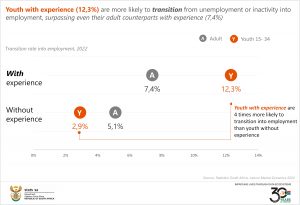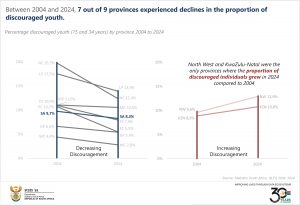Unemployment in South Africa: A Youth Perspective
South Africa, like many countries globally, grapples with the challenge of youth unemployment. This is supported by statistics indicating a 45,5% unemployment rate among young individuals (aged 15-34 years), in contrast to the national average of 32,9% in the first quarter of 2024.
However, when looking at the Labour Market Dynamics in South Africa report for 2022, which tracks individuals over multiple quarters using annual panel data released by Statistics South Africa, youth with some form of experience far surpass adults in transitioning from unemployment or inactivity into employment between quarters, with rates of 12,3% and 7,4% respectively.
Even more stark is the difference in transition rates between youth without experience and those with experience. The experience “dividend” reveals that youth with experience outperform youth without experience by a margin of 4 to 1. Clearly, initiatives such as experiential learning, apprenticeships, or other forms of exposure to the workplace have far-reaching implications in addressing the scourge of youth unemployment.
The data further reveals that the youth’s overall transition rate into employment was 4,7% in 2022, an increase of 1,2 percentage points from 3,5% in 2021. In the same period, adult rates remained unchanged at 6,7%.
A person’s chances of landing and keeping a job are also greatly influenced by their level of education. Compared to those without matric, those with tertiary education have a greater chance of transitioning from unemployment or inactivity into employment.
Education plays a crucial role in equipping young people with the skills and competencies necessary to succeed in the workforce. However, according to the Quarterly Labour Force Survey (QLFS) for the 1st Quarter of 2024, only 9,8% of the employed youth were graduates. Limited educational attainment, as well as social and economic disadvantages, are the primary factors driving elevated rates of unemployment, and the significant proportion of youth not in employment, education, or training (NEET), in South Africa.
Young females often encounter challenges securing decent employment compared to their male counterparts. Education emerges as a key determinant in enhancing access to better job prospects.
According to the Labour Market Dynamics in South Africa (LMDSA), 2022 report, individuals with tertiary qualifications exhibit a higher likelihood of transitioning into employment from periods of unemployment or inactivity compared to those without matriculation. Notably, men demonstrate a greater tendency to transitioning into employment relative to women, recording rates of 6,5% and 4,6% respectively in 2022.
According to the data, young women display heightened vulnerability in the labour market when compared to young men. In 2024, the absorption rate of young men was 31,9%, outpacing young women, whose rate stood at 24,2%. The unemployment rate among young females was estimated at 49,4% in 2024, marking a notable increase of 3,3 percentage points from 46,1% in 2004.
Generally, females exhibit high levels of unemployment alongside lower absorption and labour force participation rates compared to males. The Labour Force Participation Rate (LFPR) is the proportion of the working-age population that is either employed or unemployed while the Absorption Rate (AR) is the proportion of the working-age population that is employed. Additionally, women are often burdened with family responsibilities. This can impede their educational attainment and, subsequently, their advancement within the South African labour market.
The nine provinces in the country display diversity in labour market dynamics, with variations in employment trends. Access to opportunities is also dependent upon geographical location, with urban areas generally offering better employment prospects than rural. For instance, the Western Cape exhibits higher absorption rates and lower levels of unemployment as compared to KwaZulu-Natal and the Eastern Cape.
Discouraged job seekers, who were available for work but did not actively seek employment during the reference period, constituted a noteworthy demographic. In 2024, only 2,8% of young individuals aged between 15 and 34 years were categorised as discouraged in the Western Cape, whereas this figure stood at 13,9% in Limpopo. Over the span of 2004 to 2024, seven out of the nine provinces experienced declines in the proportion of discouraged youth, with the Northern Cape experiencing the most significant reduction of 7,3 percentage points. Conversely, the North West (with an increase of 3,3 percentage points) and KwaZulu-Natal (with an increase of 1,9 percentage points) were the only provinces where the number of discouraged individuals grew in 2024 compared to 2004.
Efforts to address youth unemployment require a comprehensive approach encompassing education reform, skills development initiatives, and targeted employment programs. Collaboration between the government, private sector, and civil society is essential to create an enabling environment for youth employment. Moreover, policies promoting entrepreneurship and small business development can empower young people to create their own opportunities.
Addressing youth unemployment not only contributes to economic growth but also fosters social cohesion and reduces inequality, laying the foundation for a more inclusive and prosperous society.
For more information, download the QLFS Q1:2024 report and Labour Market Dynamics in South Africa report for 2022.



